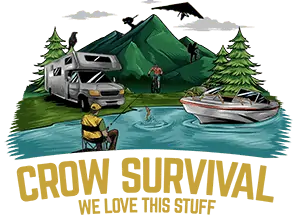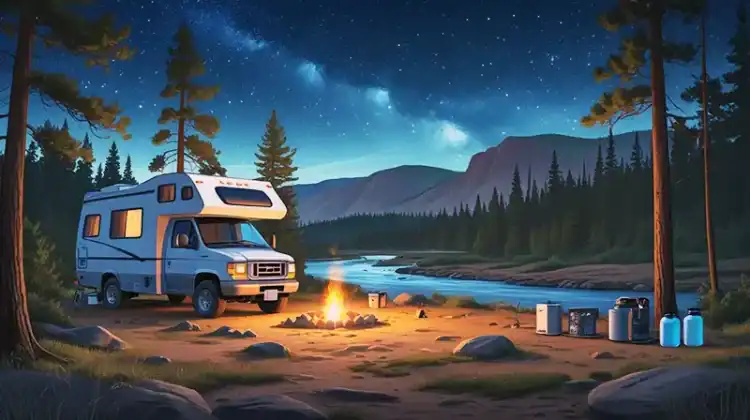
Thank you for reading our post, please rate this article at the end.
Reading Time: 12 minutesLast Updated on September 22, 2025 by Paul Clayton
Table of Contents
Boondocking Like a Pro: Off-Grid RV Freedom
Key Takeaways
-
- Definition & Types: Boondocking involves camping without hookups, typically in remote locations. It’s distinguished from “dry camping” (no hookups but potentially amenities/fees) and “dispersed camping” (free camping on public lands like BLM or National Forests, usually with 14-day limits).
- Benefits: Offers cost savings (no campground fees), increased privacy and solitude, and greater flexibility without reservations.
- Challenges: Requires careful management of water, power, and waste resources, making you dependent on your RV’s self-sufficiency. Weather and limited connectivity can also pose challenges.
- Finding Sites: Reliable tools include The Dyrt PRO (offline maps), Campendium, iOverlander, and FreeRoadsites.net. Always scout locations for level ground, safe access, and solar exposure, and adhere to land use regulations.
- Self-Sufficiency Essentials:
- Power: Solar panels (at least 200 watts recommended), MPPT solar charge controllers, and robust batteries (Lithium recommended for best performance) are crucial, along with inverters for AC power.
- Water: Conservation is key (3-4 gallons/person/day), utilizing water-saving showerheads, “navy showers,” and maximizing tank capacity with portable containers.
- Waste: Managed through black and gray tanks, emphasizing biodegradable products and using designated dump stations. Portable waste tanks can extend stays.
- Connectivity: Cell signal boosters (like WeBoost) are vital for remote areas, with backup data sources and offline maps.
- Etiquette & Community: Success also relies on following Leave No Trace principles (pack out everything, never dump waste), respecting other campers’ privacy, practicing fire safety, and being mindful of wildlife. Connecting with online communities and fellow RVers provides valuable shared knowledge.
Boondocking opens up a world of freedom that traditional RV camping simply can’t match. Instead of being tied to crowded campgrounds with hookups, you can wake up to stunning mountain views, desert sunsets, or peaceful forest clearings, all while enjoying the comfort of your RV. This style of camping puts you in control of where and how long you stay, without reservation fees or noisy neighbors.
Successful boondocking requires mastering three key areas: understanding your RV’s capabilities, managing your power and water resources, and knowing how to find safe, legal camping spots. Many RVers feel overwhelmed by the idea of camping without hookups, but with the right preparation and knowledge, anyone can learn to live comfortably off-grid for days or even weeks at a time.
We’ll walk you through everything from evaluating whether your RV is ready for boondocking to finding those perfect hidden campsites that seasoned boondockers treasure. You’ll discover practical strategies for extending your stays, managing your resources like a pro, and joining the community of RVers who have embraced this rewarding lifestyle. Whether you’re planning your first dry camping adventure or looking to improve your off-grid skills, this guide will give you the confidence to boondock successfully.
New vs. Used RV: Navigating the Price Trends
Can You Rent an RV for a Year?
Boondocking Fundamentals
Boondocking involves camping without hookups to water, electricity, or sewer systems, typically in remote locations. Understanding the differences between camping styles, location types, and the trade-offs of off-grid living forms the foundation for successful boondocking adventures.
Boondocking vs. Dry Camping and Dispersed Camping
Boondocking refers to camping in remote areas without any amenities or hookups. We’re talking about truly isolated spots where you rely completely on your RV’s systems.
Dry camping happens when we camp without hookups but still have some amenities nearby. This might be at a campground without electrical or water connections, or overnight parking at a Walmart.
Dispersed camping specifically refers to camping on public lands managed by agencies like the Forest Service or Bureau of Land Management. These areas allow free camping for up to 14 days in most locations.
The key difference lies in location and amenities. Boondocking emphasizes remote, pristine locations with zero facilities. Dry camping can happen anywhere without hookups, including developed campgrounds that charge fees but don’t provide utilities.
Wild camping is another term some use interchangeably with boondocking. However, this typically refers to tent camping in undeveloped areas rather than RV camping.
Types of Boondocking Locations
BLM land offers some of the best free camping opportunities in the western United States. These areas typically allow 14-day stays before you need to move 25 miles away.
National Forest lands provide similar opportunities with beautiful settings. We can usually camp for free on most forest service roads and designated dispersed camping areas.
State trust lands vary by state but often allow overnight camping. Some require permits while others operate on a first-come basis.
Private boondocking locations include farms, ranches, and businesses that allow overnight parking. These sometimes charge small fees but offer unique experiences.
Overnight parking at truck stops, rest areas, and retail stores works for short stays while traveling. Always check local laws and ask permission when possible.
Seasonal considerations matter greatly. Desert locations work best in the winter months, while mountain areas open up during the summer. Popular spots fill quickly during peak seasons.
Benefits and Challenges of Off-Grid Living
Cost savings represent the biggest benefit of off-grid living. We avoid campground fees that range from $30 to $80 per night at many RV parks.
Privacy and solitude let us enjoy nature without crowded campgrounds and noisy neighbors. We wake up to wildlife instead of generators and traffic.
Flexibility means no reservations or check-in times. We travel at our own pace and stay longer in places we love.
Resource management becomes our biggest challenge. We must carefully monitor water usage, battery power, and waste tank levels daily.
Weather dependency affects our comfort and safety. Extreme temperatures strain our systems and may force us to seek shelter or hookups.
Limited connectivity means spotty cell service and internet access. This can be a benefit or a challenge depending on our work and communication needs.
Maintenance demands increase when we’re self-sufficient. Equipment failures become more serious when we’re miles from repair services.
Finding and Selecting Boondocking Sites
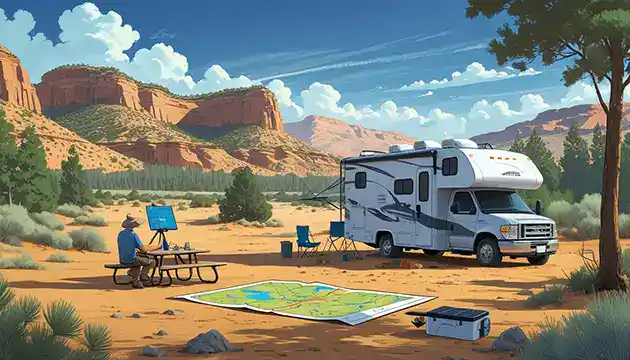
Success in boondocking depends on finding the right spots and choosing them wisely. We need reliable tools to locate free camping areas and must understand the legal requirements for different types of public land.
Research Tools and Mobile Apps
Digital tools make finding boondocking sites much easier than before. The Dyrt PRO offers offline maps and shows BLM land boundaries even without cell service. This costs $35.99 per year and works well in remote areas.
Campendium focuses specifically on free camping spots. Users share photos and detailed reviews of boondocking sites. The app shows exact GPS coordinates and access road conditions.
iOverlander works well for RV travel and includes user-generated content about boondocking spots. It shows amenities like dump stations and water sources nearby.
FreeRoadsites.net lists thousands of free camping locations across all 50 states. The website includes Walmart parking lots and other overnight parking options for quick stops.
We can download maps before leaving areas with good cell service. This prevents getting stuck without information on remote dirt roads.
Location Scouting and Site Assessment
Good boondocking spots have level ground for RVs and safe access roads. We should look for established fire rings and cleared areas that show previous camping use.
Solar exposure matters for RV travel with solar panels. South-facing slopes get more sun throughout the day. Trees provide shade but block solar charging.
Water sources nearby help extend stays on BLM land. Springs and streams reduce the water we need to carry. Always treat natural water before drinking.
Check road conditions before committing to a site. Steep grades or deep sand can trap RVs. Rain can make dirt roads impassable quickly.
Distance from main roads affects noise levels and privacy. Sites closer to highways have more traffic sounds but easier access.
Legal Considerations and Land Use
BLM land allows 14 days of free camping in most areas. We must move at least 25 miles away before returning to the same general area.
Forest Service lands have similar 14-day limits but different rules for each forest. Some areas close during fire season or wildlife protection periods.
Private land requires permission from the owners. Posted signs show property boundaries and camping rules.
State and local laws can override federal camping rules. Some counties ban overnight parking even on BLM land within their borders.
We must camp in previously used sites when possible. Creating new camping spots damages vegetation and violates Leave No Trace principles.
Check current fire restrictions before selecting boondocking sites. Red flag warnings can change daily during dry seasons.
Mastering Self-Sufficiency and Resource Management
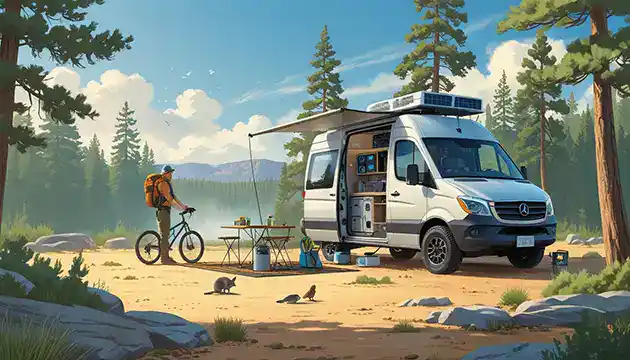
Successful RV boondocking requires careful planning of your power, water, waste, and communication systems. Each system plays a vital role in extending your off-grid camping adventures while maintaining comfort and safety.
Power Solutions for Off-Grid RVs
Solar power forms the backbone of any serious boondocking setup. We recommend starting with at least 200 watts of solar panels for basic needs.
A quality solar charge controller with MPPT technology maximizes power collection. This device prevents battery overcharging and optimizes energy transfer from panels to batteries.
Battery selection matters greatly:
- Lead-acid batteries: Budget-friendly but heavy
- AGM batteries: Maintenance-free, better performance
- Lithium batteries: Lightweight, longest lifespan, fastest charging
Deep-cycle batteries store the power your solar panels collect during the day. Size your battery bank to handle at least two days without sun.
An inverter converts 12V battery power to 120V AC power for standard appliances. Choose pure sine wave inverters for sensitive electronics.
Essential monitoring tools include:
- Battery monitor to track charge levels
- Solar charge controller display
- Volt meter for quick checks
Water Storage and Conservation
Water management can make or break your boondocking experience. Most RVers use about 3-4 gallons per person daily when conserving.
Maximize storage capacity by filling all tanks before departure. Consider portable water containers for extended stays in prime locations.
Install a water-saving showerhead with an on-off switch. This simple upgrade can cut shower water use by 50% or more.
Navy showers save significant water. Get wet, turn off the water, soap up, then rinse quickly.
Conservation strategies that work:
- Use paper plates for some meals
- Collect cold water while waiting for hot water
- Install low-flow faucet aerators
- Reuse gray water for flushing when legal
Monitor your water gauge daily. Track usage patterns over several trips to predict how long your supply will last.
Waste Management and Sanitation
Smart waste management extends your boondocking stays and protects the environment. Black tank capacity usually determines how long you can stay put.
Use biodegradable toilet paper and holding tank treatments. These break down waste faster and reduce odors.
Extend tank capacity by:
- Using campground restrooms when available
- Installing a portable waste tank for longer stays
- Limiting food scraps in gray water
- Taking shorter showers to reduce gray water volume
Empty tanks only at designated dump stations. Never dump waste on the ground or in regular toilets.
Carry extra trash bags and pack out all garbage. Reduce waste volume by minimizing packaging and choosing reusable items.
Staying Connected Off the Grid
Communication becomes challenging in remote boondocking locations. Cell towers are often far away or blocked by terrain.
A WeBoost cellular signal booster amplifies weak signals significantly. These devices can mean the difference between no service and usable internet.
Multiple data sources provide backup:
- Primary carrier unlimited plan
- Secondary carrier hotspot device
- Satellite internet for extreme locations
Position external antennas as high as possible. Even small elevation changes can improve signal strength dramatically.
Download offline maps and entertainment before leaving cell coverage. Weather radios provide emergency information when cellular fails completely.
Test all communication equipment before departing. Verify data plan limits and roaming charges to avoid expensive surprises.
Boondocking Tips, Etiquette, and Community
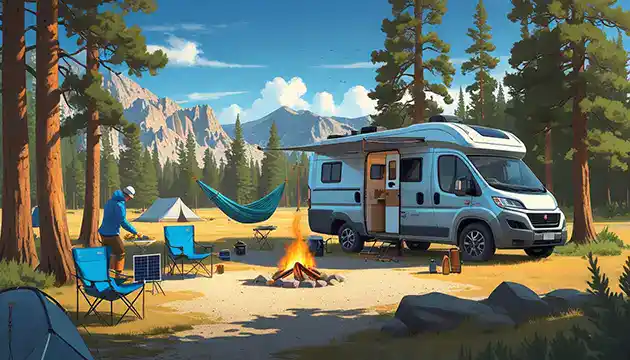
Success in boondocking comes from mastering practical skills, following proper etiquette rules, and building connections with fellow RVers. These three elements work together to create safe, respectful, and enjoyable off-grid experiences.
Practical Boondocking Tips
We recommend arriving at your boondocking site early in the day to assess the area properly. Survey the ground for rocks, holes, or slopes that could damage your RV or make leveling difficult.
Always park with your nose pointed toward the exit. This tactical parking method lets you leave quickly in emergencies. Back into your site whenever possible to achieve this setup.
The weather becomes more serious when boondocking. We check forecasts multiple times and prepare backup plans. Remote areas can trap you during storms or high winds.
Essential items to pack:
- Road atlas or paper maps
- Emergency weather radio
- Extra water containers
- Portable fire pit
- First aid kit
GPS fails in remote areas where cell towers are sparse. We carry physical maps as backup navigation tools. Battery-powered devices can die when you need them most.
Water conservation extends your stay significantly. We limit showers to two minutes and collect rinse water for cleaning dishes. Grey water stretches further with biodegradable soaps.
Boondocking Etiquette and Environmental Impact
Leave No Trace forms the foundation of all boondocking etiquette. We pack out everything we bring in, including food scraps and grey water. Dumping tanks on the ground damages ecosystems and can close camping areas permanently.
Respect other campers by maintaining distance. We move as far away as possible from occupied sites since people boondock for privacy and quiet. This courtesy applies even in large open areas.
Fire safety requires extra attention in remote locations. We clear dry materials from around fire pits and completely extinguish flames before leaving. Never burn trash, as it leaves harmful residue and attracts wildlife.
Wildlife encounters increase in natural boondocking areas. We store all food inside our RV and clean up meal scraps immediately. Bears and other animals learn to associate campers with food sources.
Pet owners must keep animals leashed or contained. We never let pets run free around other campers or in areas with dangerous wildlife. Unleashed pets disturb both wildlife and neighboring campers.
Connecting With the RV Boondocking Community
Online communities provide valuable resources for finding boondocking spots and sharing experiences. We use apps like Campendium and iOverlander to discover new locations and read recent reviews.
Popular boondocking resources:
- Facebook groups for specific regions
- Forums like Cheaprvliving.com
- YouTube channels with location guides
- State and federal land websites
Fellow boondockers often share information about water sources, dump stations, and road conditions. We exchange contact information with experienced campers we meet on the road.
Many areas host informal gatherings where boondockers meet for meals or campfires. These events help newcomers learn from veterans while building lasting friendships.
We participate in citizen science projects and volunteer opportunities in the areas where we camp. This gives back to public lands while connecting with like-minded RVers who value conservation.
Local businesses near boondocking areas often welcome RVers for supplies and services. We support these communities by shopping locally and recommending favorite spots to other travelers.
Frequently Asked Questions
New boondockers often have questions about legal camping spots, preparation steps, reliable apps for location scouting, and essential gear selection. Understanding RV features and knowing where to find legitimate free camping sites helps ensure successful off-grid adventures.
What are the legal considerations to keep in mind when boondocking?
Always verify camping regulations before setting up camp on public lands. Most Bureau of Land Management and National Forest areas allow free camping for 14 days, but specific rules vary by location.
Check fire restrictions and seasonal closures before you arrive. Some areas close during certain months to protect wildlife or prevent fire hazards.
Respect private property boundaries and never camp without permission. Trespassing can result in fines and legal issues that ruin your trip.
Follow Leave No Trace principles to protect the environment. Pack out all trash, use established fire rings, and camp only in designated areas when required.
Some states have different rules for overnight parking in rest areas or parking lots. Research local laws to avoid tickets or being asked to move.
How can beginners prepare for their first boondocking experience?
Start with shorter trips of 2-3 days to test your setup and learn your limits. This helps you understand how much water, power, and supplies you actually use.
Practice conserving resources at home first. Take shorter showers, use paper plates occasionally, and turn off lights to build good habits.
Make detailed checklists for food, water, power, and emergency supplies. Planning prevents you from forgetting essential items or running out of necessities.
Choose beginner-friendly locations with cell service and nearby towns. This gives you backup options if something goes wrong.
Test all your equipment before leaving home. Check your battery levels, water pumps, and solar panels to avoid surprises.
Which websites and apps are the most reliable for finding boondocking locations?
Campendium offers detailed reviews and photos from real boondockers. The app includes GPS coordinates, cell service reports, and difficulty ratings for each spot.
FreeRoam provides offline maps and filtering options for different camping types. You can search by state, amenities, and RV size restrictions.
iOverlander works well for finding both established and remote camping spots. The community updates information regularly with current conditions and access roads.
Recreation.gov lists official government campgrounds and dispersed camping areas. This site provides accurate information about permits and seasonal restrictions.
GaiaGPS helps with navigation to remote locations using detailed topographic maps. The offline capability works when cell service disappears in backcountry areas.
What are the essential items to bring along when boondocking?
Fresh water storage beyond your main tank extends your stay significantly. Bring extra water jugs or collapsible containers for drinking and cooking needs.
Portable power sources like solar panels or generators keep your batteries charged. Lithium batteries hold more power and last longer than traditional lead-acid options.
Propane for cooking, heating, and hot water should be topped off before departure. Carry backup propane canisters for extended trips.
Emergency supplies include first aid kits, flashlights, and basic tools for repairs. Cell phone boosters help maintain communication in remote areas.
Waste management tools, such as portable dump tanks or extra storage, help you manage waste more efficiently. Biodegradable soaps protect the environment when washing dishes outside.
How do I identify the best RV types suitable for boondocking?
Look for RVs with large fresh water tanks and increased battery capacity. Models designed for boondocking typically hold 100+ gallons of fresh water and have 400+ amp hours of battery storage.
Solar panel packages and inverters come standard on many boondocking-ready RVs. These systems convert stored power to run household appliances and electronics.
Smaller, lighter RVs access more remote locations than large motorhomes. Class B vans and smaller travel trailers fit on narrow forest roads and tight camping spots.
Consider fuel efficiency for extended travel to remote locations. Diesel engines typically provide better mileage when hauling or driving larger RVs long distances.
Tank monitors and LED lighting help conserve resources during extended stays. These features let you track usage and extend your time between dump station visits.
Can you provide tips for finding free and legal boondocking spots?
Bureau of Land Management lands offer the most free camping opportunities across western states. Most BLM areas allow 14-day stays with basic amenities like fire rings and vault toilets.
National Forest dispersed camping provides beautiful settings in most states. Look for established camping areas along forest service roads rather than creating new sites.
State trust lands sometimes allow camping with permits or day passes. Contact local offices to verify current policies and obtain required permissions.
Walmart and some truck stops permit overnight parking in their lots. Call ahead or check with store managers to confirm their current overnight policies.
Join online communities and forums where boondockers share current information. These groups provide real-time updates about road conditions, closures, and new camping spots.
Final Thoughts
Boondocking offers unparalleled freedom and a deep connection with nature, allowing RVers to escape crowded campgrounds and enjoy vast, often free, remote landscapes. While it demands a strong understanding of your RV’s capabilities and diligent resource management (power, water, waste), the challenges are entirely surmountable with proper planning, the right equipment, and a commitment to responsible outdoor practices.
Embracing boondocking transforms RV travel into a truly self-sufficient and rewarding adventure, opening up a world of hidden gems for those willing to learn the ropes and live off-grid like a seasoned pro.
Home page
Back to the top of the page
